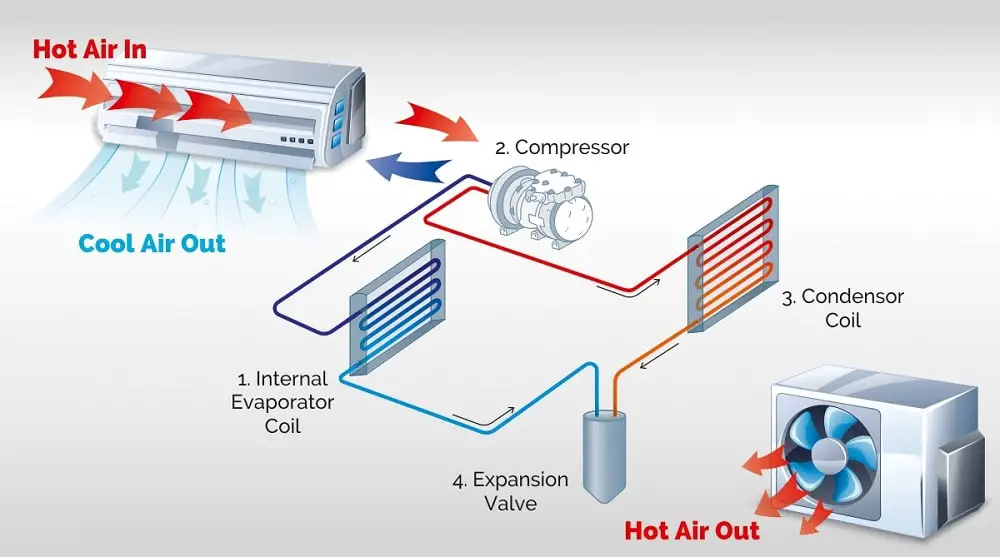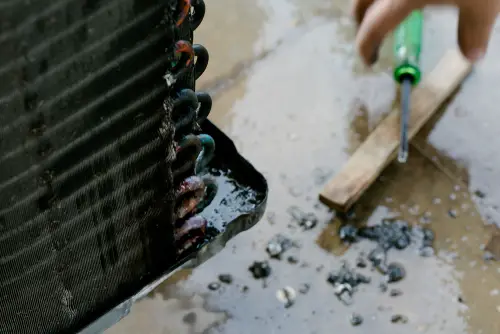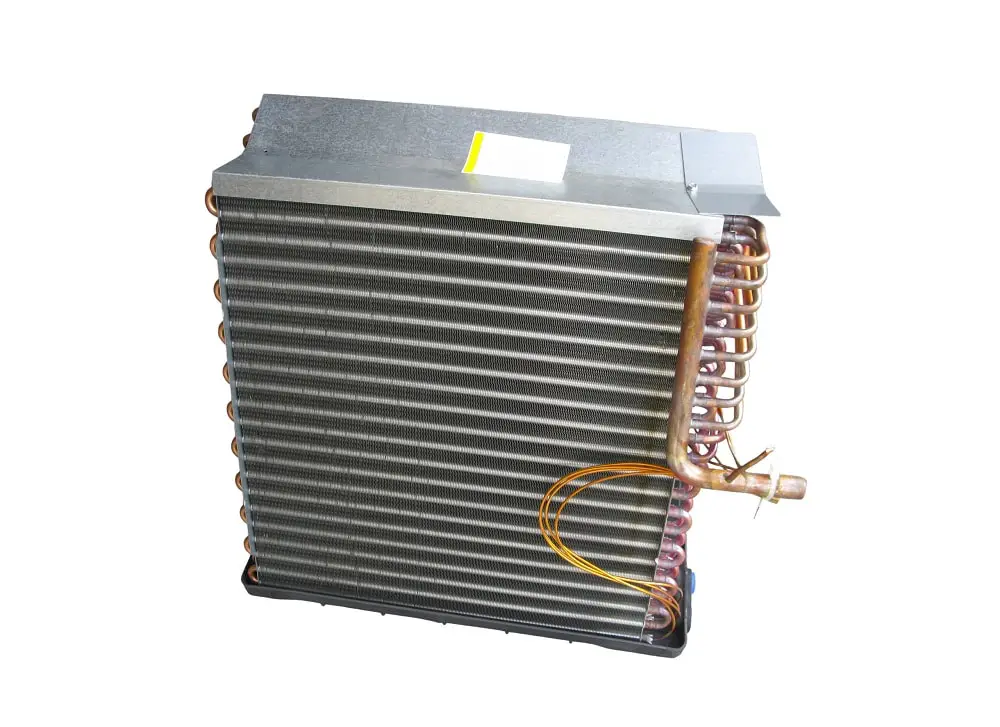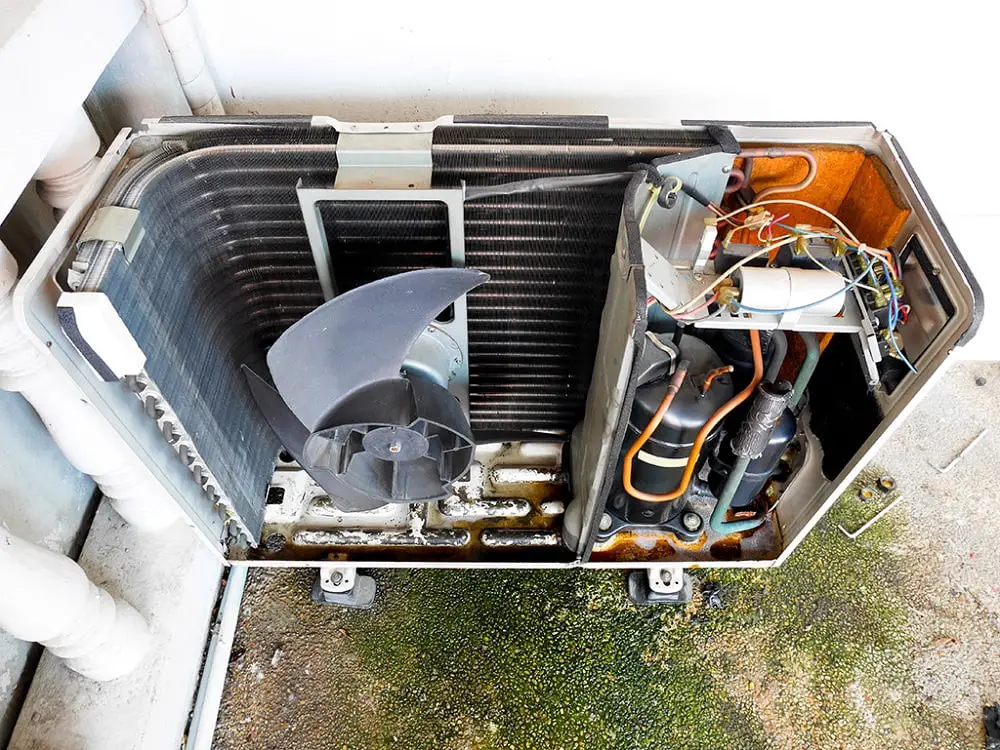Have you wondered what is inside those metal boxes that house your air conditioner?
Your air conditioner uses fundamental physics to take heat and moisture out of the air inside your home and dump it back into the environment outside.
It’s essential to understand the difference between the two and why they’re placed where they are. So, we will explain the how and why and give you some idea of the problems associated with air conditioning.
The first thing to understand is the system’s components and how they do the job of cooling the air inside the room. Read on to learn the secrets of those plastic and metal boxes.

How Condenser and Evaporator Coils Work
Both of these may be coils but they work differently. Here’s a graphic to help you understand the differences.

What is a Condenser Coil and How Does It Work?
According to the dictionary, the word condense means, “to change or make something change from a gas to a liquid or solid state.” This is precisely what the condenser unit in your air conditioner will do.
So let’s look at what it is and the mechanics.
The condenser unit will be housed in the large square box placed outside your house as this unit takes the heat out of the air coming from the house. It’ll consist of a metal cover that protects the fragile internals from weather and anything that may damage them.
Inside will be something that looks similar to the radiator in your car. It’s a set of copper tubes surrounded by aluminum fins, a compressor unit, fans, switches, and electrical wiring.
The refrigerant gas contained in your air conditioner will absorb heat from the air circulating inside your home. It’s then transferred through the wall via copper pipes to the condenser unit outside.
Here the warm, low-pressure refrigerant gas moves into the compressor. The compressor does what its name implies and it compresses this warm, low-pressure gas.

The result of this compression is hot, high-pressure gas that flows into the condenser coils. At this point, the temperature of the gas is around 100°F so that the cooling will occur even on the hottest of days.
Condenser coils are copper tubes surrounded by aluminum fins. The coils are manufactured from copper tubes bent into a wavy pattern and surrounded by aluminum fins. These many coils are designed to make the overall length of the lines longer, resulting in more fins to increase the area exposed to the air.
As the hot gas is pumped through the tubes, the gas’s heat is transferred to the fins. Fans blowing air across the unit will remove the heat from the fins. This slowly reduces the temperature of the gas, condensing it back to a warm liquid.
From the condenser coil, it flows back through more copper pipes back into your home to repeat the process of collecting heat, moving it back outside, and cooling down.
Types of AC Condensers
There are three types of condensers, air-cooled, water-cooled, and a combination of the two.
Air-Cooled
This type of condenser is usually fitted to domestic properties as well as small shops and factories. It’s the least expensive and most straightforward to install as it requires no additional infrastructure such as water pipes.
Water-Cooled
As its name implies, this type of condenser has water reticulated around the cooling fins to remove the heat. Water is a far more efficient medium for the transfer of heat, but using this type of cooling requires infrastructure in the form of water and cooling the water or continuously replacing the water. The most common form of cooling the water is the use of a cooling tower.
Combination Air and Water-Cooled
These condensers are known as evaporative condensers and are most often found in ice plants. Here the hot gas flows through pipes that have water continually sprayed over them.
In addition to the water being sprayed over the coils, the air is drawn from the unit’s base and blown out of its top.
This has the effect of rapidly evaporating the water that lands on the copper coils increasing the chilling effect.

What is an Evaporator Coil and How Does it Work?
The evaporator coil has just one job: to extract heat from the air inside the room and pass that heat on to the coils’ refrigerant liquid.
The evaporator coil is installed inside the air handler for the air conditioning unit. As it’s installed inside the building, it’s exposed continually to the warm air inside that’s drawn over it by the fan installed along with the evaporator.
Inside the evaporator are copper tubes is the chilled refrigerant-liquid that has been cooled by the condenser unit outside. The temperature of the liquid refrigerant is approximately 40°F.
Hot air from the room is drawn into the air handling unit with a fan. It passes over the copper tubing of the evaporator coil. As it passes over the coil, the chilled refrigerant absorbs the heat energy from the air, and the cooled air is then blown back into the room.
As the warm air passes over the copper tubes, condensation naturally occurs on the tubes, which lowers the air’s humidity levels in the air pushed back into the room.
As the refrigerant liquid absorbs heat, it’s slowly converted back to a gas that then flows out through copper pipes back to the condenser unit outside. The entire process begins again.

Types of AC Evaporators
There are three basic types of evaporator coils, and we will look at each one.
Vertical Evaporator Coil
As the name implies, these are usually found in vertical air conditioning units. In this type of unit, the air flows either up or down as it blows over the evaporator coils. These vertical coils take the condensation created and drain the water away, lowering the room’s humidity.
Cased Evaporator Coil
Again, the name gives us a good indication of how this type of coil is housed. The coils are positioned horizontally and are covered with a metal case. These are the most common type of evaporator coil. They fulfill the same function as the vertical coils, with the difference being their shape and size.
Uncased Evaporator Coil
These coils are ideal for unusual air conditioning configurations as they can be placed either horizontally or vertically and aren’t encased by metal plates. The lack of metal coverings makes these coils infinitely customizable and can be configured to any shape. Skilled technicians should only fit this type of coil to ensure the unit’s proper functioning.
Relevant Characteristics Between Condenser and Evaporator Coils
Condenser vs Evaporator Coils
Compare by tapping or clicking below!

Location
Condenser Coils
Housed outside
Evaporator Coils
Housed inside
Function
Condenser Coils
To remove heat from the refrigerant gas moving inside the condenser coils
Evaporator Coils
To remove heat and moisture from the air sucked in from the room
Heat Transfer Process
Condenser Coils
Heat is transferred from the refrigerant gas moving the condenser coil to air passing over the coils
Evaporator Coils
Heat is transferred from the air passing over the coils to the refrigerant gas moving inside the evaporator coils
Condenser and Evaporator Coil Differences
Here are some of the biggest ways these differ.
Location
The evaporator coils are either inside the room to be cooled, or if this is a self-contained unit, they’ll be at the front of the air conditioner, closest to the building’s interior. As the condenser coils give up heat to the environment, they’re housed either outside in a metal cabinet or self-contained units at the rear of the casing.
Function
Both condenser and evaporator coils facilitate the transfer of heat. The evaporator coils will allow the chilled refrigerant gas to move inside the coils to absorb heat from the air passing over them. At the same time, water condenses on the coils and drips into a tray that empties outside. This removes humidity from the air.
The condenser coils facilitate heat transfer from the hot gas contained within the coils to the outside air. As this happens, the gas gradually condenses back into a liquid, is cooled, and is passed back to be pumped to the evaporator again.

Heat Transfer Process
In the evaporator, the heat is transferred from the hot air drawn in from the room. As the refrigerant liquid slowly warms, it evaporates and becomes a gas. This gas is then pumped to the compressor housed close to the outside. It’s compressed, heating it further, and then it travels through the condenser coils. The condenser coils give up heat to the air that’s continuously blown over the coils. This causes the gas to condense back into a liquid slowly.
Common Condenser Coil Issues
You should be aware of three main problems and take steps to avoid these issues raising their head.
Refrigerant Leaks
These condenser coil tubes are thinly walled. Suppose one cracks or a joint develops a small hole. In that case, this will allow the refrigerant to escape and upset the balance inside the unit. Lack of refrigerant will compromise the heat transfer inside the room and heat transfer via the condenser coils to the environment.
Symptoms of leaks in the condenser coils include warm air coming from the air handler inside the room, icing of the coils, and compressor problems as the unit attempts to compress less and less gas.
Dirty Condenser Coils
It’s natural for the condenser coils to attract dust, which sticks to the water condensing outside the tubes. Suppose this dirt isn’t cleaned off regularly.
In that case, the dirt will form an insulating jacket that will compromise the coil’s ability to transfer heat to the environment.
Condenser Fan Problems
The fan is an essential component of the condenser. It draws the air used for cooling over the condenser coils, facilitating the constant transfer of heat.
Worn belts, electrical wiring problems, or motor problems can affect the fan’s effective operation.

Why and How Should I Keep My AC Coils Clean?
Both the evaporator and condenser coils rely on exposure to the air conditioning unit’s environment to work efficiently.
The coils will naturally attract dust, especially the condenser coils outside. As the transfer of heat occurs, water condenses naturally on the outside of the coils. This moisture attracts dust and soon a muddy insulating jacket forms, which stops the efficient transfer of heat, impairing the creation of cool air.
In addition to low efficiency, you could see an increase in electrical consumption. The unit works harder to maintain the requested temperature. As the unit works harder, it places strain on all the components, and premature failure of these components is possible.
It’s not difficult to avoid the problems associated with dirty coils. They simply need to be kept clean, and this is a task that’s well within the capability of anyone. Undertake this task regularly.
Remember you’ll use water to clean the coils, so make sure you turn the unit off at the mains before starting. Water and electricity don’t mix!

Tips on Properly Maintaining Condenser Coils
Cleaning the condenser coils outside is a relatively simple task. You can take a damp cloth and carefully wipe each coil, removing the dust.
For slightly more dirt, try using a spray bottle containing water and some mild cleaner. Spray the coils and carefully wipe off the dirt.
For a heavy coating of dirt, take the garden hose and gently rinse the dust and dirt off of the coils. Dry the coils, and leave the condenser unit open to allow all the water to dry before turning it on again. Don’t use a high-pressure washer. You can easily damage the coils.
Tips on Properly Maintaining Evaporator Coils
For the evaporator coils, open the air handler and, using a wet cloth, gently wipe the coils and clean the dirt away.
Use a gentle household cleaner to assist in cleaning.
Are Evaporator Coils and Condenser Coils Required to Be Changed Out Together?
A question that’s often asked is: Is it essential to match the condenser and evaporator coils’ size or capacity? The simple answer is: Yes, it’s imperative.
The evaporator and condenser coils are designed to work together to remove the heat and moisture from the interior. This means that the evaporator coils should absorb as much heat as the condenser coils can dump back into the environment. Conversely, the condenser coils should be able to dump the heat drawn in by the evaporator.

Problems of Mismatched Condenser and Evaporator Coils
If you choose not to match these coils, you may experience some of the following issues. While these won’t cause serious dangers, it can still be inconvenient and cost you more in the long run .
Higher Costs
If the coils are mismatched, you’ll see higher energy costs as the unit will be forced to work both harder and longer. The smaller set of coils will cause the entire unit to work longer. The circulating refrigerant won’t be effectively heated or cooled, depending on which set of coils is smaller.
Lifespan of the Unit
Mismatched coils will result in the entire system operating under stress. This stress means that all the components work harder and longer, resulting in failure of the parts, or the whole system will collapse.
Poor Cooling
Mismatched coils will result in inefficient use of the refrigerant. This will result in the unit’s poor performance, and you’ll find increased humidity and warmer than expected air coming from the air handler.
Warranty Problems
The air conditioner warranty will clearly state that the evaporator and condenser coils must be a matched set. Should you replace one or the other incorrectly, you’ll void any warranty left on the unit.

Bottom Line
Air conditioning units work on a simple physical principle, the absorption, and release of heat. To accomplish this, the units must be correctly sized for the rooms to be cooled and kept clean, and they’ll run efficiently for years.
Most residential units are fitted with Type 1 air conditioning units. These are the traditional split units, where the air handler is inside and the condenser unit is outside.
These are very efficient and provided some general maintenance is carried out to ensure there are no leaks and the condenser coils are kept clean, they’ll work efficiently for many years.
Type 2 air conditioners have a heat pump facility that works in conjunction with a home furnace. Heat pump units can bring extra warmth into your home for those freezing nights. This type of unit is suited to areas that regularly experience low temperatures in winter.
Whichever unit you choose, make sure to get some professional advice, have it sized to fit your environment, and maintain it regularly.
An air conditioning unit that works well will bring your family many years of comfortable living through hot weather as well as cold.
People Also Ask
Many people are nervous to ask a technician questions about their air conditioner. Often, they don’t want to interrupt or know that it may cost them another hour of labor. Here are some of the most frequently asked questions:
There are three main symptoms of a dirty condenser coil:
1. You’ll notice that your air conditioner runs for long periods instead of switching on and off to maintain the room’s temperature. This will result in higher energy bills.
2. The air coming from the air handler inside the room isn’t as cool as it should be.
3. The humidity inside the room is noticeably higher than usual.
Though we see the condenser as a single unit, it’s made up of several components, including fans, motors, circuit boards, and cooling coils. One or more components can fail at any one time.
The costs of replacement for a residential unit can run from around $400 to $1,200. You’ll also need to factor in the price of labor to complete the job. These costs range from around $50 per hour to $150 per hour.
A condenser has to be slightly larger than the evaporator. It not only has the coils that facilitate the transfer of heat, but it also has a compressor that pressurizes the gas, before it’s passed into the coils. All of this extra equipment adds to the bulk of the unit.
The costs to replace evaporator coils are very much dependent on how difficult it is to access the air handling unit, as this will push up the labor costs. Prices for the replacement should be in the region of $200 to $1,000, depending on the unit’s make and size. You’ll also have to factor in $400 to $1,000 for labor.
